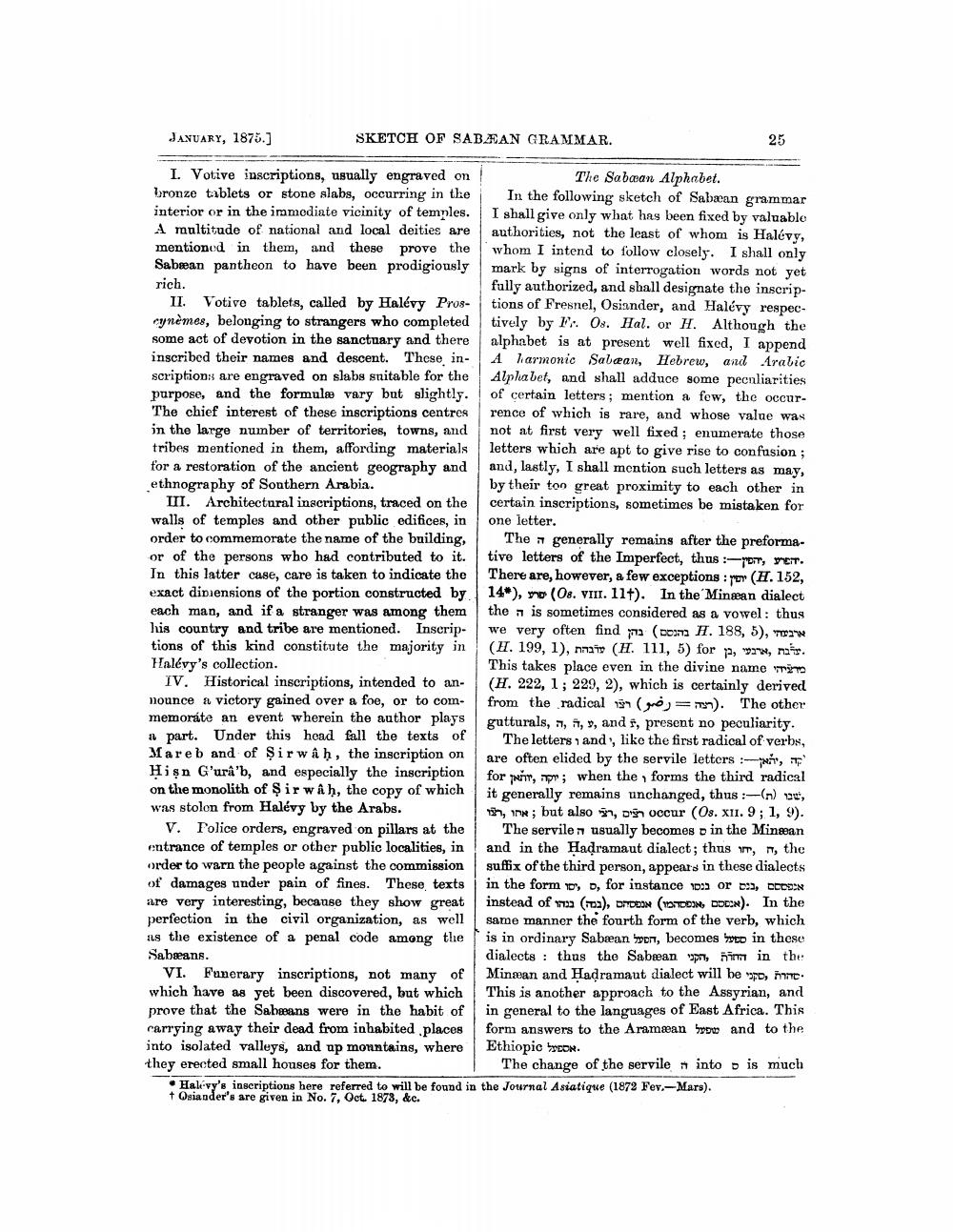________________
JANUARY, 1875.]
SKETCH OF SABÆAN GRAMMAR.
I. Votive inscriptions, usually engraved on!
The Sabæan Alphabet. Ironze tablets or stone slabs, occurring in the i In the following sketch of Sabaan grammar interior or in the immediate vicinity of temples. I shall give only what has been fixed by valuable A multitude of national and local deities are authorities, not the least of whom is Halévy, mentioned in them, and these prove the whom I intend to follow closely. I shall only Sabean pantheon to have been prodigiously mark by signs of interrogation words not yet rich.
fully authorized, and shall designate the inscripII. Votive tablets, called by Halévy Pros- tions of Fresnel, Osiander, and Halévy respecaynèmes, belonging to strangers who completed tively by 1. 08. Hal. or H. Although the some act of devotion in the sanctuary and there alphabet is at present well fixed, I append inscribed their names and descent. These in- A larmonic Salaan, Hebrew, and Arabic scriptions are engraved on slabs snitable for the Alphabet, and shall adduce some pecnliarities purpose, and the formulæ vary but slightly. of certain letters; mention a few, the occur. The chief interest of these inscriptions centres rence of which is rare, and whose value was in the large number of territories, towns, and not at first very well fixed; enumerate those tribes mentioned in them, affording materials letters which are apt to give rise to confusion; for a restoration of the ancient geography and and, lastly, I shall mention such letters as may, ethnography of Sonthern Arabia.
by their too great proximity to each other in III. Architectural inscriptions, traced on the certain inscriptions, sometimes be mistaken for walls of temples and other public edifices, in one letter. order to commemorate the name of the building, The generally remains after the preformaor of the persons who had contributed to it. tive letters of the Imperfect, thus :-DT, yet. In this latter case, care is taken to indicate the There are, however, a few exceptions : yor (H. 152, exact dinensions of the portion constructed by 14*), no (Os. vir. 11t). In the Minwan dialect each man, and if a stranger was among them then is sometimes considered as a vowel: thus his country and tribe are mentioned. Inscrip- we very often find 773 (com H. 188, 5), 72 tions of this kind constitute the majority in (H. 199, 1), mai (H. 111, 5) for 7, 2w, nats. Halévy's collection.
This takes place even in the divine name mima IV. Historical inscriptions, intended to an (H. 222, 1; 229, 2), which is certainly derived nounce a victory gained over a foe, or to com- from the radicalin ( =en). The other memorate an event wherein the author plays gutturals, , , , and s, present no peculiarity. 1 part. Under this head fall the texts of
The letters 1 and, like the first radical of verbs, Mareb and of Şirwah, the inscription on
are often elided by the servile letters :Hisn G'urâ'b, and especially the inscription for přin, pr; when the forms the third radical on the monolith of Sirwah, the copy of which it generally remains unchanged, thus :-(n) at, was stolon from Halévy by the Arabs.
in, ink; but also in, Diin occur (Os. XII. 9; 1, 9). V. Police orders, engraved on pillars at the The servilen usually becomes in the Minean entrance of temples or other public localities, in and in the Hadramaut dialect; thus , n, the order to warn the people against the commission suffix of the third person, appears in these dialects of damages under pain of fines. These texts in the form o, for instance 103 or 3, COCON are very interesting, because they show great instead of a (a), DHODIN (1TDD, DDCON). In the perfection in the civil organization, as well same manner the fourth form of the verb, which is the existence of a penal code among the is in ordinary Sabean won, becomes w in these Sabæans.
dialects: thus the Sabean , him in the VI. Funerary inscriptions, not many of Minwan and Hadramaut dialect will be , hone. which have as yet been discovered, but whichThis is another approach to the Assyrian, and prove that the Sabaans were in the habit of in general to the languages of East Africa. This carrying away their dead from inhabited places form angwers to the Aramæan 500w and to the into isolated valleys, and up monntains, where Ethiopic N. they erected small houses for them.
The change of the servile into is much • Hak vy's inscriptions here referred to will be found in the Journal Asiatique (1872 Fev.-Mars). + Osiander's are given in No. 7, Oct. 1873, &c.




